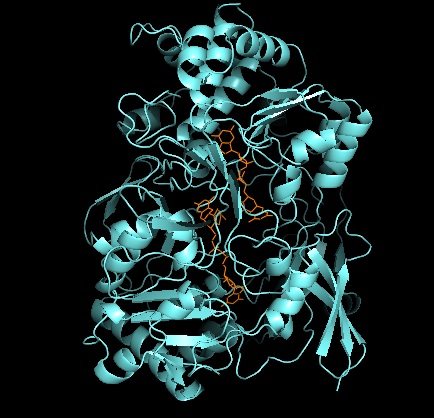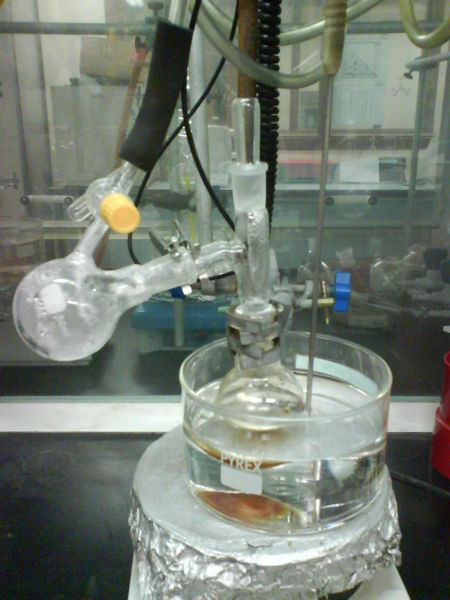|
DMSO Reductase
DMSO reductase is a molybdenum-containing enzyme that catalyzes reduction of dimethyl sulfoxide (DMSO) to dimethyl sulfide (DMS). This enzyme serves as the terminal Oxidoreductase, reductase under anaerobic conditions in some bacteria, with DMSO being the terminal electron acceptor. During the course of the reaction, the oxygen atom in DMSO is transferred to molybdenum, and then reduced to water. DMSO reductase (DMSOR) and other members of the DMSO reductase family are unique to bacteria and archaea. Enzymes of this family in anaerobic oxidative phosphorylation and inorganic-donor-based lithotrophic respiration. These enzymes have been engineered to degrade oxoanions. DMSOR catalyzes the transfer of two electrons and one oxygen atom in the reaction: The active site of DMSOR contains molybdenum, which is otherwise rare in biology. Tertiary structure and active site As for other members of DMSO reductase family, the tertiary structure of DMSOR is composed of Mo-surrounding d ... [...More Info...] [...Related Items...] OR: [Wikipedia] [Google] [Baidu] |
Molybdenum
Molybdenum is a chemical element; it has Symbol (chemistry), symbol Mo (from Neo-Latin ''molybdaenum'') and atomic number 42. The name derived from Ancient Greek ', meaning lead, since its ores were confused with lead ores. Molybdenum minerals have been known throughout history, but the element was discovered (in the sense of differentiating it as a new entity from the mineral salts of other metals) in 1778 by Carl Wilhelm Scheele. The metal was first isolated in 1781 by Peter Jacob Hjelm. Molybdenum does not occur naturally as a Native metal, free metal on Earth; in its minerals, it is found only in oxidation state, oxidized states. The free element, a silvery metal with a grey cast, has the List of elements by melting point, sixth-highest melting point of any element. It readily forms hard, stable carbides in alloys, and for this reason most of the world production of the element (about 80%) is used in steel alloys, including high-strength alloys and superalloys. Most molybdenum ... [...More Info...] [...Related Items...] OR: [Wikipedia] [Google] [Baidu] |
Methanesulfonic Acid
Methanesulfonic acid (MsOH, MSA) or methanesulphonic acid (in British English) is an organosulfuric, colorless liquid with the molecular formula and structure . It is the simplest of the alkylsulfonic acids (). Salts and esters of methanesulfonic acid are known as mesylates (or methanesulfonates, as in ethyl methanesulfonate). It is hygroscopic in its concentrated form. Methanesulfonic acid can dissolve a wide range of metal salts, many of them in significantly higher concentrations than in hydrochloric acid (HCl) or sulfuric acid (). History and synthesis Early history German chemist Hermann Kolbe discovered MSA between 1842 and 1845 and originally termed it methyl hyposulphuric acid. The discovery stemmed from earlier work by Berzelius and Marcet in 1813, who treated carbon disulfide with moist chlorine and produced a compound they named "sulphite of chloride of carbon". By reacting it with barium hydroxide Kolbe demonstrated it to actually be trichloromethylsul ... [...More Info...] [...Related Items...] OR: [Wikipedia] [Google] [Baidu] |
Sulfur Cycle
The sulfur cycle is a biogeochemical cycle in which the sulfur moves between rocks, waterways and living systems. It is important in geology as it affects many minerals and in life because sulfur is an essential element (CHNOPS), being a constituent of many proteins and cofactor (biochemistry), cofactors, and sulfur compounds can be used as oxidants or reductants in microbial respiration. The global sulfur cycle involves the transformations of sulfur species through different oxidation states, which play an important role in both geological and biological processes. Steps of the sulfur cycle are: * Mineralization of Organosulfur compounds, organic sulfur into inorganic forms, such as hydrogen sulfide (H2S), elemental sulfur, as well as sulfide minerals. * Oxidation of hydrogen sulfide, sulfide, and elemental sulfur (S) to sulfate (). * Reduction of sulfate to sulfide. * Incorporation of sulfide into organic compounds (including metal-containing derivatives). * Disproportionation ... [...More Info...] [...Related Items...] OR: [Wikipedia] [Google] [Baidu] |
Reporter Gene
Reporter genes are molecular tools widely used in molecular biology, genetics, and biotechnology to study gene function, expression patterns, and regulatory mechanisms. These genes encode proteins that produce easily detectable signals, such as fluorescence, luminescence, or enzymatic activity, allowing researchers to monitor cellular processes in real-time. Reporter genes are often fused to regulatory sequences of genes of interest, enabling scientists to analyze promoter activity, transcriptional regulation, and signal transduction pathways. Common reporter gene systems include green fluorescent protein (GFP), β-galactosidase (lacZ), luciferase, and chloramphenicol acetyltransferase (CAT), each offering distinct advantages depending on the experimental application. Their versatility makes reporter genes invaluable in fields such as drug discovery, gene therapy, and synthetic biology. Common Reporter Genes To introduce a reporter gene into an organism, scientists place the ... [...More Info...] [...Related Items...] OR: [Wikipedia] [Google] [Baidu] |
Escherichia Coli
''Escherichia coli'' ( )Wells, J. C. (2000) Longman Pronunciation Dictionary. Harlow ngland Pearson Education Ltd. is a gram-negative, facultative anaerobic, rod-shaped, coliform bacterium of the genus '' Escherichia'' that is commonly found in the lower intestine of warm-blooded organisms. Most ''E. coli'' strains are part of the normal microbiota of the gut, where they constitute about 0.1%, along with other facultative anaerobes. These bacteria are mostly harmless or even beneficial to humans. For example, some strains of ''E. coli'' benefit their hosts by producing vitamin K2 or by preventing the colonization of the intestine by harmful pathogenic bacteria. These mutually beneficial relationships between ''E. coli'' and humans are a type of mutualistic biological relationship—where both the humans and the ''E. coli'' are benefitting each other. ''E. coli'' is expelled into the environment within fecal matter. The bacterium grows massi ... [...More Info...] [...Related Items...] OR: [Wikipedia] [Google] [Baidu] |
DMSO Reductase Proposed Mechanism
Dimethyl sulfoxide (DMSO) is an organosulfur compound with the formula . This colorless liquid is the sulfoxide most widely used commercially. It is an important polar aprotic solvent that dissolves both polar and nonpolar compounds and is miscible in a wide range of organic solvents as well as water. It has a relatively high boiling point. DMSO is metabolised to compounds that leave a garlic-like taste in the mouth after DMSO is absorbed by skin. In terms of chemical structure, the molecule has idealized Cs symmetry. It has a trigonal pyramidal molecular geometry consistent with other three-coordinate S(IV) compounds, with a nonbonded electron pair on the approximately tetrahedral sulfur atom. Synthesis and production Dimethyl sulfoxide was first synthesized in 1866 by the Russian scientist Alexander Zaytsev, who reported his findings in 1867. Its modern use as an industrial solvent began through popularization by Thor Smedslund at the Stepan Chemical Company. Dimethyl sulf ... [...More Info...] [...Related Items...] OR: [Wikipedia] [Google] [Baidu] |
Electron Paramagnetic Resonance
Electron paramagnetic resonance (EPR) or electron spin resonance (ESR) spectroscopy is a method for studying materials that have unpaired electrons. The basic concepts of EPR are analogous to those of nuclear magnetic resonance (NMR), but the spins excited are those of the electrons instead of the atomic nuclei. EPR spectroscopy is particularly useful for studying metal complexes and organic radicals. EPR was first observed in Kazan State University by Soviet physicist Yevgeny Zavoisky in 1944, and was developed independently at the same time by Brebis Bleaney at the University of Oxford. Theory Origin of an EPR signal Every electron has a magnetic moment and spin quantum number s = \tfrac , with magnetic components m_\mathrm = + \tfrac or m_\mathrm = - \tfrac . In the presence of an external magnetic field with strength B_\mathrm , the electron's magnetic moment aligns itself either antiparallel ( m_\mathrm = - \tfrac ) or parallel ( m_\mathrm = + \tfrac ) to the fie ... [...More Info...] [...Related Items...] OR: [Wikipedia] [Google] [Baidu] |
X-ray Absorption Spectroscopy
X-ray absorption spectroscopy (XAS) is a set of advanced techniques used for probing the local environment of matter at atomic level and its electronic structure. The experiments require access to synchrotron radiation facilities for their intense and tunable X-ray beams. Samples can be in the gas phase, solutions, or solids. Background XAS data are obtained by tuning the photon energy, using a crystalline monochromator, to a range where core electrons can be excited (0.1-100 keV). The edges are, in part, named by which core electron is excited: the principal quantum numbers n = 1, 2, and 3, correspond to the K-, L-, and M-edges, respectively. For instance, excitation of a 1s electron occurs at the metal K-edge, K-edge, while excitation of a 2s or 2p electron occurs at an metal L-edge, L-edge (Figure 1). There are three main regions found on a spectrum generated by XAS data, which are then thought of as separate spectroscopic techniques (Figure 2): # The ''absorption thresho ... [...More Info...] [...Related Items...] OR: [Wikipedia] [Google] [Baidu] |
Rhodobacter Sphaeroides
''Rhodobacter sphaeroides'' is a kind of purple bacterium; a group of bacteria that can obtain energy through photosynthesis. Its best growth conditions are anaerobic phototrophy ( photoheterotrophic and photoautotrophic) and aerobic chemoheterotrophy in the absence of light. ''R. sphaeroides'' is also able to fix nitrogen.De Universiteit van Texas over ''Rhodobacter sphaeroides'' It is remarkably metabolically diverse, as it is able to grow ically via and [...More Info...] [...Related Items...] OR: [Wikipedia] [Google] [Baidu] |
X-ray Crystallography
X-ray crystallography is the experimental science of determining the atomic and molecular structure of a crystal, in which the crystalline structure causes a beam of incident X-rays to Diffraction, diffract in specific directions. By measuring the angles and intensities of the X-ray diffraction, a crystallography, crystallographer can produce a three-dimensional picture of the density of electrons within the crystal and the positions of the atoms, as well as their chemical bonds, crystallographic disorder, and other information. X-ray crystallography has been fundamental in the development of many scientific fields. In its first decades of use, this method determined the size of atoms, the lengths and types of chemical bonds, and the atomic-scale differences between various materials, especially minerals and alloys. The method has also revealed the structure and function of many biological molecules, including vitamins, drugs, proteins and nucleic acids such as DNA. X-ray crystall ... [...More Info...] [...Related Items...] OR: [Wikipedia] [Google] [Baidu] |






